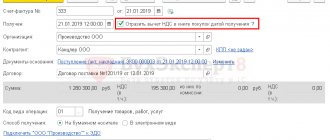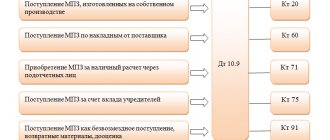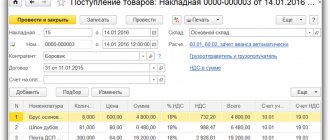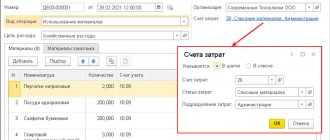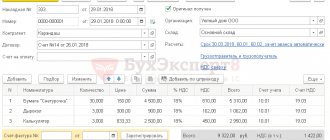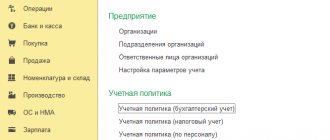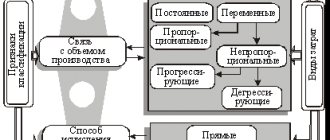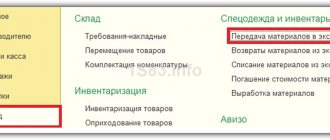Regulatory framework for developing write-off standards
The development and approval of standards for the write-off of building materials for a specific enterprise should be based on basic rules and regulations. The main working documents are:
- SNiP 82-01-95 “Development and application of norms and standards for the consumption of material resources in construction”;
- RDS 82-201-96 “Rules for the development of standards for material consumption in construction.”
SNiP 82-01-95 establishes more general provisions for rationing materials in construction, RDS 82-201-96 complements and specifies most of the aspects, and also contains examples of calculations.
The basic quantities of consumption and type of materials are determined by the requirements for the construction project. For example, the composition of the concrete used may differ for an industrial workshop building and for a residential building. In this aspect, one should be guided by GOST and SanPiN standards for construction, as well as the opinions of technical experts.
There are other types of specific documents involved in standardization:
- GESN - state elemental estimate standards. They indicate the permissible estimated values of material consumption for specific types of construction work;
- MDS - methodological documents in construction. They contain instructions for the use of GESN.
The main body issuing the regulatory documents listed above is the State Construction Committee of Russia. Although other executive bodies (for example, the Ministry of Health), research institutions and even enterprises in the construction industry are usually involved in the development.
ConsultantPlus experts tell you in detail how to take into account building materials. Get free demo access to K+ and go to the Ready Solution to find out all the details of this procedure.
How can an accountant deal with the write-off of materials for construction and installation work?
Once again, I recently came across a question about the write-off of materials when performing construction and installation work: what to do if the KS-2, which was compiled by the customer, does not indicate all the materials that we actually used?
I would like to note right away that the Certificate of Acceptance of Work Completed, the form of which (No. KS-2) was approved by Decree of the State Statistics Committee of Russia dated November 11, 1999 No. 100, confirms that the result of the work indicated in it in quantitative and monetary terms was transferred by the contractor and accepted by the customer. It is the basis for the contractor to reflect the cost of implementing the completed construction and installation work, and for the customer to take their result into account at the same cost.
Determine, on the basis of KS-2, the actual cost of the work performed (that is, the cost), even if the act lists in as much detail as possible all (more precisely, almost all) materials that the contractor should have used in their implementation, not only actually, but even and theoretically impossible.
Without going into detail about the rules for drawing up* KS-2, as well as KS-3, KS-6a, and other forms of documentation for recording work in construction, we only note that they indicate the contractual cost of the work performed. may also be indicated. However, it is far from a fact that the contractor used only these materials, and only in the quantity specified in the act.
* The official duties of an accountant of a construction organization do not include, and should not include, the conclusion of contracts with customers, the determination of the estimated (contractual) cost of the work performed, as well as the preparation of the mentioned acts and certificates. This is a different specialty, different powers, different salary. You can, of course, combine them, but only if you combine your salaries.
The basis for writing off materials in quantitative and monetary terms as costs incurred during construction and installation works are other documents.
The first such document is a report on the consumption of materials for construction and installation works . It should be compiled by that employee of the organization, under whose strict guidance specific work is performed for a specific customer - foreman, foreman, foreman, site manager, etc., etc., etc.
As a guide to action when drawing up such a report (its form, procedure for filling out, checking, approving), it is optimal to take the Instructions approved almost forty years ago on the procedure for drawing up a monthly report of the head of the construction site (work manager) on the consumption of basic materials in construction in comparison with the consumption, determined according to production standards, according to form No. M-29.
This Instruction was approved by the USSR Central Statistical Office (Central Statistical Office of the Union of Soviet Socialist Republics) with its outgoing number 613 dated November 24, 1982.
It is optimal, in my opinion, to develop your own report form, using the M-29 as a model. And it is precisely this report that will serve as the basis for writing off materials for the cost of construction and installation work and comparing the actual consumption of materials for work performed with the consumption determined according to production standards, that is, agreed with the customer.
But norms are norms, and a fact is a fact. And most often, the actual consumption of materials will differ, both more and less, from what it was provided for in the contract with the customer and, possibly, indicated in KS-2.
If the foreman (foreman, site manager) actually spent more materials than was foreseen, then there was an overexpenditure.
In this case, it is optimal for management to request an explanatory note from him about the reasons for this. And if this reason is considered worthy of attention and understanding (the overconsumption of materials is technically justified or caused by production necessity), then permission may be given to write off such overruns as costs. Otherwise, the management has the right to demand compensation from such a work manufacturer for the damage caused to them.* * Once again, I would like to draw your attention to the fact that the accounting department should in no way take on the responsibilities of production workers for checking the M-29. This is not her diocese.
If less materials were used than stipulated by the standards (contract, estimate), but not to the detriment of the quality of the work performed, then there is a reasonable saving.
And after the report is approved by management (chief engineer, director, or other employee entrusted with such responsibility), it will serve as the basis for attributing them to the cost of work performed.
The work contractor provides a material report to the accounting department, in which he must reflect all the movement of materials that are assigned to him. Veterans of the accounting construction front still call it the Report on Form M-19. However, I was unable to find a legal act that approved this form. Apparently, this was quite a long time ago.
It indicates the balance of materials listed for a given employee at the beginning of the month, their receipts, expenses, and the balance at the end of the month. And the consumption of materials for production must correspond to the consumption according to M-29.
And on the basis of the material report, the accounting department evaluates the materials used for the production of construction and installation works, the validity of the expenditure of which is confirmed by production workers.
Thus, the material costs for the production of construction and installation work are justified and documented. Therefore, no one can claim that they cannot be recognized for income tax purposes. All requirements of paragraph 1 of Art. 252 of the Tax Code of the Russian Federation are fully complied with.
This document flow scheme when writing off materials for construction and installation work has been successfully used for decades. Therefore, I don’t see much point in changing it. But no one forbids the development of some other scheme if it allows one to reliably determine the actual consumption of materials for the production of construction and installation work.
However, I repeat once again that in any case, the responsibility for justifying the need to write off specific materials for specific types of work rests with employees of the production department. The task of accounting is only their valuation.
Hello Guest! Offer from "Clerk"
Online professional retraining “Accountant on the simplified tax system” with a diploma for 250 academic hours . Learn everything new to avoid mistakes. Online training for 2 months, the stream starts on March 15.
Sign up
The procedure and content of the process of rationing building materials
The process of standardization in construction consists of regulating the use of building materials during the execution of work. The main stages of standardization are:
- Analysis of the conditions under which construction work will take place. At this stage the following is carried out:
- final selection of materials (taking into account the requirements of technical design documentation, GOST and SNiP);
- organization of the work process;
- definition of a unit of work;
- determination of consumables to complete a unit of work.
IMPORTANT! A unit of construction product is a component of the construction flow. Construction flow - uniform, continuous execution of construction work (progress). When standardizing, the following can be taken as a unit:
- separate area of work;
- part of an object under construction (for example, a foundation or a wall);
- one entire object or a group of homogeneous objects (for example, the construction phase of a cottage community of 20 standard houses);
- takeover is a private flow that covers several elements of the main one (for example, custom finishing of part of the apartments in a new building).
- Determination of the standard consumption of each building material per unit of work. According to RDS 82-201-96, cost standards can be:
- Enlarged - by complex of works. They are used at the design stage to select technological solutions.
IMPORTANT! Integrated standards cannot be used to write off building materials.
- Averaged - according to estimate documentation. Needed to determine the total amount of resources required for construction.
IMPORTANT! Average standards cannot be used to control the actual write-off of materials, as well as for payments for construction work (between customers and contractors).
- Elemental - consumption for the selected unit of construction work. They are the ones that should be used when calculating and approving standards for write-off of materials during construction work (as well as for settlements between customers and contractors).
- Monitoring compliance with consumption standards when performing work and adjusting standards if necessary. Here we should mention another specific thing in the construction process - normal.
Normal is an indicator or characteristic that most fully corresponds to the technical process. Determined taking into account a set of parameters. For standard work, there are usually already developed standards that can be relied upon when developing write-off standards.
The main principle of rationing is the unity of the normal and the standard. If the consumption according to the established standard leads to a deviation from the norm, the standard needs to be revised.
EXPLANATIONS from ConsultantPlus: From January 1, 2021, FSBU 5/2019 “Inventories”, approved by Order of the Ministry of Finance dated November 15, 2019 No. 180n, is in effect. PBU 5/01 and Guidelines for accounting of inventories have become invalid. ConsultantPlus experts explained in detail what has changed in accounting. Get trial access to the system for free and go to the Ready-made solution.
What laws set limits on the write-off of building materials?
There is no firm rule in accounting laws according to which materials must be written off for production. However, paragraph 92 of the Order of the Ministry of Finance dated December 28, 2001 No. 119n states that materials must be released from the warehouse in accordance with the standards of the production program. This rule assumes that write-offs cannot be uncontrolled.
The volumes during the operation must comply with approved standards. There is also Article 252 of the Tax Code of the Russian Federation, according to which all expenses of an enterprise must be supported by documents. Spending must also be reasonable from an economic point of view.
The company independently approves consumption standards based on the following documents:
- SNiP 82-01-95. Here are the general rules. RDS 82-201-96. Here you can find answers to specific questions, as well as examples of calculations.
When approving standards, specific papers may also be used:
- GESN. The document specifies standards for specific types of construction. MDS. Here you can find recommendations for using GESN.
The basic volumes for write-off will depend on the construction project.
For example, the concrete used in the construction of a residential or industrial building will vary. The standards regarding this aspect are given by GOST and SanPiN. Expert opinions may also apply.
The limits approved by the enterprise must be fixed in estimates and various internal documents.
Documents are compiled by the department responsible for the technological process. After the papers are developed, the director of the company must approve them. Write-offs must be made in accordance with established standards.
It is possible that the approved limit may be exceeded, but this situation should alert the manager. In particular, he will need to establish the reasons for exceeding the standards. For example, this could be defective materials or technological losses.
IMPORTANT! Write-off of materials in excess of approved standards can only be done with the permission of the manager.
On the primary documentation (invoice, act), a note is placed on the supply of building materials in excess of the limit and the reasons for such an operation. If the write-off is carried out without complying with these rules, it will be unlawful. Such actions can lead to distortion of costs and the entry of incorrect data in tax reporting and accounting.
Methods for developing elemental write-off standards
Write-off rates per unit of production are determined by consumption rates per unit of work operation.
Calculation formula:
N = ni1Ki1 + ni2Ki2 +… + niiKii,
Where:
N is the write-off rate per unit of construction product;
ni is the consumption rate for a working operation;
Ki is a coefficient that takes into account the share of a unit of work operation in the total volume of construction products;
Ki= Elemental unit of production / Enlarged unit of production.
Detailed rules for calculating, presenting and rounding numerical values of norms for write-off of building materials are presented in clause 5 of RDS 82-201-96.
To set elemental standards per unit of work operation, the following methods are used:
- Production - consists of observing a similar operation directly at a construction site and measuring the volume of work performed and materials spent on it. Most often used for materials that have hard-to-remove losses (we will talk about this in more detail later).
- Laboratory - observations and measurements are made in specially created conditions. It is usually used in cases where it is necessary to determine the influence on the process of a factor (for example, the density of sand from different batches) or a set of factors (for example, the influence of different weather conditions on a new type of material).
- Calculation and analytical - consists of carrying out theoretical calculations based on available statistical data on similar designs and technologies.
IMPORTANT! When taking measurements, several approaches must be performed (at least 5 according to RDS 82-201-96). For different categories of building materials, a different number of approaches can be established to bring data to an acceptable error. Tables of the dependence of approaches on the category of materials are presented in the RDS.
Methods for assessing materials when they are written off
To correctly write off building materials, it is necessary to correctly analyze their cost. According to legislative acts on accounting, special materials are taken into account based on their actual price.
The actual cost is the amount of costs, including:
- initial cost;
- transport expenses;
- cost of consultations;
- customs state duty;
- cost of intermediary services.
In case of write-off of special materials sent for construction or any other disposal, the determination of the actual cost must be carried out individually for each type of building material during the reporting period using one of the proposed methods:
- Determination of the cost of each unit of supplied building materials. The most suitable option for accounting for particularly valuable inventory items.
- Determination of the average cost value. It is a mathematical division of the total cost of the entire complex of materials by the number of accounting units.
- Using the First In, First Out principle - first in, first out. – special materials received last are removed from the balance sheet first.
- Using the Last In, First Out method is the opposite principle - building materials put on the balance sheet at the very beginning are written off.
Drawing up standards for write-off of building materials
The obtained measurement results are analyzed to determine the base value of the norm. After this, you can begin to draw up standards for the write-off (consumption) of materials for the operation. Usually the result is presented in a table that indicates the unit of the work operation, the name of the material, its unit of measurement and the standard.
Example (based on RDS 82-201-96)
Unit of work operation: laying 1 m3 of a wall made of ceramic stone facing with sand-lime brick.
Process technology:
- Making a bed out of mortar.
- Laying ceramic stones.
- Cladding with silicate bricks.
According to the measurement results and calculations:
| Material | Unit | Consumption rate per 1 m3 of wall with an average architectural design of 2 bricks, with an opening of 20% |
| Ceramic stone 250 × 120 × 65 mm | PC. | 212 |
| Single silicate brick | PC. | 107 |
| Cement-lime mortar | m3 | 0,24 |
Next, using the above formula, you can calculate the required amount of materials, for example, for a wall with a design cubic capacity of 500 m3.
The rules for calculating the volumes of building structures also have their own specifics, set out in detail in the RDS.
Standardization procedure
Standardization includes the following stages:
Analysis of the circumstances of construction work. Includes the selection of building materials, establishing a unit of work, planning the construction execution process. Setting limits for each material per unit of work.
The types of standards are specified in RDS 82-201-96. Control over the implementation of limits. If limits are violated every now and then, it makes sense to adjust them. Norms must correspond to objective reality.
NOTE! When rationing, the concept of normal is often used. There are standards for standard forms of work that can be used to set limits.
Approval of standards for write-off of building materials
Write-off standards are approved by the persons responsible for their development and application:
- head of the production and technical department (PTO);
- chief construction engineer (or a person with similar responsibility and authority);
- head of the enterprise.
In the future, the normalized costs of building materials are included in separate columns in the act for writing off materials. Next to them, information about the materials actually written off is entered. The act completed in this way is approved again by the responsible persons and the manager. It is also possible that the manager, on the basis of an act, issues an order to write off the building materials specified in the act.
For the unified form of the act of writing off building materials, see the article “Unified form No. M-29 - form and sample.”
IMPORTANT! The accounting department of an enterprise has a rather indirect relationship to the very approval of norms for writing off building materials, although it actively uses the norms in the future to solve problems of accounting and control of construction costs.
Read more about accounting methods for creating the cost of written-off materials in the publication “Procedure for writing off materials at average cost”.
Documentation of storage and movement of materials
Materials in a construction organization can be stored in closed warehouses and open areas. Regardless of the storage location, all inventories are assigned to the materially responsible person. The movement of materials between warehouses is documented with an internal movement invoice. An invoice is issued and material assets are released for construction to the foremen with the permission of the foreman. Read also the article: → “Form OS-2. Invoice for internal movement of fixed assets."
At the end of the month, storekeepers submit reports on inventory balances to the central warehouse. Based on this information, a summary report is compiled at the central warehouse with a breakdown of information about the movement of inventory by facility, which is transmitted to the accounting department. Superintendents provide monthly material reports to the accounting department, according to which materials are written off from the warehouse.
The acquisition of material resources by a construction enterprise involves the preparation of the following documents:
- purchase and sale agreements for materials;
- supplier invoices;
- certificates and other similar documents confirming the quality of purchased materials.
If, upon receipt of goods and materials, any quantitative or qualitative discrepancies with the data of primary documents are detected, or if they are received without documents, an inventory acceptance report is drawn up. Based on it, you can later file a claim with the supplier.
If materials come from the customer, then a separate contract for their supply does not need to be drawn up.
An additional agreement or annex to the contract is sufficient, which should reflect in detail the quantity, cost and timing of the transfer of inventories to the contractor. When releasing goods from the warehouse, limit and intake cards, requirements, and invoices are drawn up. When materials are issued in excess of the norms, demands or exculpatory acts are drawn up.
Features of write-off of open storage materials
Some construction materials (sand, crushed stone, gravel, etc.) are stored in open areas and taken for work as needed, without documenting each such case.
Two features follow from this:
- such materials are usually not standardized element by element;
- the amount to be written off for the period is calculated mathematically, using inventory data at the beginning and end of the period and information about receipts during the period.
Reflection of movement on accounts
Displaying the movement of materials at the customer's location
The customer may display materials at actual cost or at book price. In the first case, their movement is taken into account on account 10 (for building materials, regardless of their type, in the “Building Materials” sub-account). If materials are transferred to the contractor for processing, then at the time of transfer they are not written off from the balance sheet, but internal postings are made within the 10th account.
Upon completion of construction, the cost of these MCs will be included in the cost of the finished facility. Materials purchased by the developer not for construction purposes are accounted for in account 10 in other subaccounts.
Features of writing off hard-to-recover losses
Losses, which are almost impossible to eliminate, may arise during the transportation of materials to the construction site during the work itself (for example, in the form of waste), in the event of possible unplanned situations. Since such losses are almost always present, the following are provided for them:
- special write-off rates presented in RDS 82-202-96;
- inclusion of estimated losses in the approved write-off rates - then the formula for calculating the write-off rate is transformed as follows:
N = NC + NPO,
Where:
NC is the net standardized consumption of materials;
NPO is the estimated rate of loss and waste.
Results
The approval of norms for the write-off of building materials is carried out by the management of engineering and technical departments and the head of the enterprise. The process of developing standards for approval has a special specificity and calculation methodology, is regulated by regulations and requires special technical knowledge.
You can find more complete information on the topic in ConsultantPlus. Free trial access to the system for 2 days.
ACT on write-off of materials for current repairs
No. _______________ dated “__” _______________ 20___
The commission consists of: chairman _____________________________________________ and commission members __________________________
_________________________________________________________ have drawn up this act stating that the following was spent on current repairs:
| No. | Item number | Name of material | Unit change (code) | Completed work | Write-off rate, quantity | Actually spent | Cor. account code | ||||
| type of work | units change | volume | quantity | price | sum | ||||||
| Total | |||||||||||
________________________________________________________________________________________________________________________
(Suma in cuirsive)
Chairman
commissions: _______________________ ______________________ _________________________
(position) (signature) (surname, acting)
Members
commissions: _______________________ ______________________ _________________________
(position) (signature) (surname, acting)
_______________________ ______________________ _________________________
(position) (signature) (surname, acting)
_______________________ ______________________ _________________________
(position) (signature) (surname, acting)
Download the document “Act on write-off of materials for current repairs”

